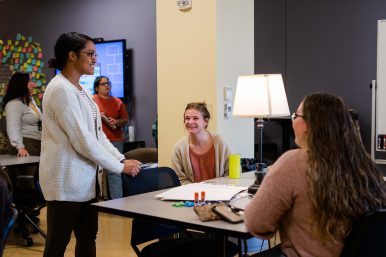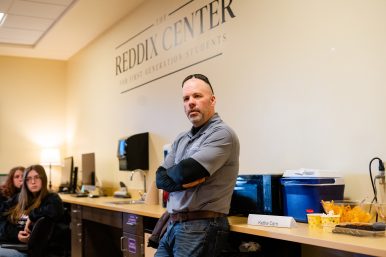
James Madison University alums Carl and Angela Reddix gave $1.1 million to start the Reddix Center for First Generation Students, which opened last fall. Photo courtesy James Madison University

James Madison University alums Carl and Angela Reddix gave $1.1 million to start the Reddix Center for First Generation Students, which opened last fall. Photo courtesy James Madison University
Support system
JMU builds on first-gen student outreach efforts
Cathy Jett //August 30, 2023//
James Madison University is where Angela Reddix says she found “my tribe, the godmothers of my children” — and also her future husband, Carl, whom she met on her first day on campus.
“All those relationships came from JMU,” says Reddix, founder, president and CEO of Norfolk-based ARDX, a health care management and IT consulting firm. “I believe I owe my success to James Madison University — my confidence, my ability to navigate this world. There’s not enough that I could give to show my appreciation to James Madison University.”
Last year, Angela Reddix made a down payment on her debt of appreciation to JMU when she and her husband contributed $1.1 million to establish the new Reddix Center for First Generation Students and a scholarship endowment, also in support of first-generation students.
Carl Reddix, who studied management and graduated in 1988, was a first-generation college student, while Angela, who graduated in 1990 with a business administration in marketing degree, was a second-generation student. Nevertheless, Angela Reddix says, “I understand from being the child of a first-generation college student how important it is, particularly when you are at a predominantly white university … that there is a support system there for you, and that you have the resources so that you don’t feel that you have to navigate that space all on your own.”
Located in the five-story Student Success Center and officially opened in November 2022, the Reddix Center offers first-generation students space for individual or group study sessions, a lounge where they can relax and meet friends, and even a place to prepare and store food. The center’s staff provides students with information about the university and helps them connect with campus resources and opportunities such as social events and career workshops. The Reddixes also plan to be personally involved in the center’s programming.
“We’ve already been able to see a good bit of community building among first-generation students and that’s something that’s been pretty cool to see,” says Jordan Cherry, a graduate student in sports and recreation leadership who mentors first-gen students through JMU’s Centennial Scholars Program.
A first-generation student himself, Cherry says it’s important for such students to have a regular gathering place and a base where they know they’ll be able to find help and make friends with others in their situation.
“A lot of the time, first-generation students … feel like they’re going through this game of college alone, and that couldn’t be further from the truth because there are a whole lot of other first-generations feeling exactly what they’re feeling,” he says. “We want to reinforce that there is a community of first-generation students who are going through the same struggles and alleviate some of those stresses and help them realize there’s a lot of resources that JMU has for them.”
Building community
The Reddix Center is designed to foster a feeling of community by providing first-generation students with a place where they can meet, get help from faculty and staff, and access special programs designed with their needs in mind. These include a one-credit-hour class called University Studies 102 that allows students to explore a major, minor or career.
“It gives them an opportunity in a structured environment, in a class setting, to have conversations with their peers and with a faculty member about the choices that they’re making as far as their career and major path,” says the center’s executive director, Shaun Mooney.
Another program will cover financial literacy, from how to create and manage a budget to how to evaluate job offers to what their retirement goals should look like. It will be taught by JMU’s Financial Aid and Scholarships Office staff as well as some alums, he says. There will also be programs devoted to helping students achieve academic success in areas where they may be struggling.
“That’s probably a first for us,” Mooney notes. “Certainly, the university has offered programs like this in the past, but we’re partnering and collaborating with offices across campus in some of our student support units to build programming specific to our first-generation students. Many of these programs are often offered or facilitated by people who are first-generation students themselves who want to come back and give back and be able to help students across that pathway.”
Mooney is working with the school’s admissions team to get the word out about the Reddix Center to prospective students and their parents.
“I’m a first-generation student and I would have loved to have a center like this accessible to me in college,” says Melinda Wood, the university’s director of admissions and associate vice president for access and enrollment. “I think it really shifts the narrative … and makes folks think about JMU differently because they know that there’s a support structure and there will be students who look like them that are a part of the center.”
However, the center is just one of several efforts by JMU to attract and retain first-generation students, who accounted for 12.2% of fall 2022 enrollment, or 2,707 students out of a total enrollment of 22,224.
JMU’s first-generation student enrollment has increased around 9% over the past decade. That’s helped James Madison’s enrollment grow at a time when many other higher education institutions are seeing declines due to demographics, rising tuition costs, anxieties about student debt and growing doubts about the value of higher education.

Total fall 2022 enrollment at JMU was nearly double its fall enrollment of 11,343 a decade earlier. Meanwhile, total enrollment at all Virginia colleges and universities fell from 539,319 in fall 2012 to 519,531 in fall 2022, a nearly 3.7% drop, according to the State Council of Higher Education for Virginia (SCHEV).
“As universities, we want students from a wide variety of backgrounds and perspectives to attend our institutions, and first-generation students and their experiences offer another lens or life experience that a group of students can bring to our campus,” says Mooney, “and I think it’s important to have their voice on campus as well.”
The university also began allowing prospective students to apply using the Common Application two years ago.
“Joining the Common Application really has opened the doors to so many more students being aware of JMU and having the opportunity to apply to the institution with just one central application platform,” says Wood. “We’re seeing greater numbers of students apply to JMU, and then having this amazing story to tell in the future [about the Reddix Center] is going to help us with those recruitment initiatives.”
‘Journey to achieve’
JMU began reaching out to first-generation students in 2004 with the Centennial Scholars Program (CSP), which provides financial assistance and an academic support network for underrepresented students. Started by former JMU President Linwood Rose, CSP was aimed at increasing diversity at the university. CSP offers full scholarships to Virginia college students who meet financial need requirements. Recipients also receive academic support, peer mentoring, interaction with faculty mentors, cultural enrichment activities and career-oriented workshops.
“We would describe those students as academically talented, highly motivated, but also Pell-eligible students,” says Mooney. “Almost all are also first-generation students.”
CSP requires students to maintain a 3.0 GPA, perform community service and participate in campus activities. Each cohort has about 50 students and more than 730 of them had graduated as of June 2022. The graduation rate for the last three cohorts was 87%, and at least 35% of those students have gone on to medical school, law school and other graduate programs, according to JMU’s website.

In 2014, JMU launched the Valley Scholars program, a college-readiness program for economically challenged students from the surrounding area. It’s focused solely on first-generation, financially eligible middle and high school students showing academic promise in JMU’s partner school districts. (These include school systems in the cities of Harrisonburg, Staunton, and Waynesboro and the counties of Augusta, Page, Rockingham, and Shenandoah.)
Valley Scholars students are selected in the spring of seventh grade and begin participating in the program’s educational and cultural enrichment opportunities in eighth grade. They also attend a weeklong summer camp between ninth and 10th grades. The goal is to equip them with the skills they’ll need to be successful academically and to increase awareness and access to colleges and universities. Those who graduate from high school having completed the program receive scholarship support to attend JMU.
Overall, the graduation rate for students in the Valley Scholars program is more than double that of Pell-eligible, first-generation students nationally, Mooney says. It’s around 75% to 80%, compared with a national graduation rate of around 30%.
“For many students, certainly the financial support is incredibly important, but building community is also critical,” Mooney says. “Students recognize that they’re not alone in their journey to achieve their degree. They have the opportunity to connect to other students. They have the opportunity to connect to other staff members and to faculty members, and develop those networking connections that are necessary to say, ‘Hey, you know, I get it. I understand the challenges that you have, the obstacles that you’re facing, and we’re here to help you.’”
James Madison University — At a glance
Founded
A public research university in Harrisonburg, James Madison University was founded in 1908 as the State Normal and Industrial School for Women. It was renamed Madison College in 1938 in honor of President James Madison and became James Madison University in 1977. Located in the heart of the Shenandoah Valley and divided by Interstate 81, JMU’s 728-acre campus is known for its distinctive bluestone buildings, as well as Newman Lake near Greek Row and the university’s 125-acre Edith J. Carrier Arboretum, which has numerous gardens and wooded areas with 100-plus-year-old oak and hickory trees.
Enrollment*
- Undergraduate: 20,346
- Graduate: 1,878
Student profile*
- Male | female ratio: 41% | 59%
- International students: 1%
- Minority students: 22%
Academic programs*
JMU has 76 undergraduate and 53 master’s degree programs, two education specialist degrees and eight doctoral programs. Fields range from accounting and computer science to international business, psychology and nursing.
Faculty*
- Full-time: 1,070
- Part-time: 393
Tuition, fees, housing and dining**
$25,840 approximate annual in-state undergraduate residential cost, including tuition, mandatory fees, housing and meal plan for incoming freshmen.
*Fall 2022
**2023-24 per year
<
















